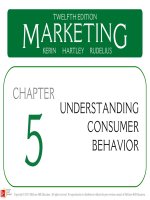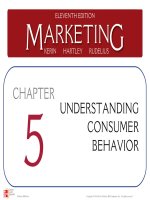Lecture Marketing (11/e): Chapter 8 – Kerin, Hartley, Rudelius
Bạn đang xem bản rút gọn của tài liệu. Xem và tải ngay bản đầy đủ của tài liệu tại đây (5.01 MB, 81 trang )
McGrawHill/Irwin Copyright © 2013 by The McGrawHill Companies, Inc. All rights reserved.
8-1
LEARNING OBJECTIVES (LO)
AFTER READING CHAPTER 8, YOU SHOULD BE ABLE TO:
LO1
Identify the reason for conducting
marketing research.
LO2
Describe the five-step marketing
research approach that leads to
marketing actions.
LO3
Explain how marketing uses secondary
and primary data.
8-2
LEARNING OBJECTIVES (LO)
AFTER READING CHAPTER 8, YOU SHOULD BE ABLE TO:
LO4
Discuss the uses of observations,
questionnaires, panels, experiments,
and newer data collection methods.
LO5
Explain how information technology
and data mining lead to marketing
actions.
LO6
Describe three approaches to
developing a company’s sales
forecast.
8-3
HOW TEST SCREENINGS AND
TRACKING STUDIES REDUCE MOVIE RISKS
What’s in a
Movie Name?
The Risks of Today’s
(and Tomorrow’s)
Blockbuster Movies
• Conduct Test
Screenings
• Use Tracking
Studies
8-4
FIGURE 8-A Marketing research questions
asked in test screenings of movies that lead
to specific actions
8-5
HOW TEST SCREENINGS AND
TRACKING STUDIES REDUCE MOVIE RISKS
Converting
Marketing Research
Results into Actions
8-6
LO1
THE ROLE OF MARKETING RESEARCH
What is Marketing Research?
The Challenges in
Doing Good
Marketing Research
Five-Step Marketing Research Approach
• Decision
• Decision Making
8-7
FIGURE 8-1 Five-step marketing research
approach leading to marketing actions
8-8
LO2
STEP 1: DEFINE THE PROBLEM
SET THE RESEARCH OBJECTIVES
Be Specific, Measurable,
and Achievable
Have a Clear
Research Purpose
Must Lead to
Marketing Actions
8-9
LO2
STEP 1: DEFINE THE PROBLEM
SET THE RESEARCH OBJECTIVES
Exploratory Research
Descriptive Research
Causal Research
8-10
LO2
STEP 1: DEFINE THE PROBLEM
IDENTIFY POSSIBLE MARKETING ACTIONS
Measures of Success
Measure of Success: Playtime
• Children Spent More Time
Playing with Old Design
• Children Spent More Time
Playing with New Design
Possible Marketing Actions
• Continue with Old Design;
Don’t Introduce New Design
• Introduce New Design;
Drop Old Design
8-11
LO2
STEP 2: DEVELOP
THE RESEARCH PLAN
Specify Constraints
Identify Data Needed
for Marketing Actions
8-12
LO2
STEP 2: DEVELOP THE RESEARCH PLAN
DETERMINE HOW TO COLLECT DATA
Concepts
• New-Product Concept
Methods
• Sampling
• Statistical Inference
8-13
LO3
STEP 3: COLLECT RELEVANT
INFORMATION/DATA
Data
Secondary Data
Primary Data
8-14
FIGURE 8-2 Types of marketing information
8-15
LO3
STEP 3: COLLECT RELEVANT INFO/DATA
SECONDARY DATA
Internal
• Marketing Input Data
• Marketing Outcome Data
8-16
LO3
STEP 3: COLLECT RELEVANT INFO/DATA
SECONDARY DATA
External
• Census Bureau
U. S.
2010
Census
American
Community
Survey
• Trade Associations
• Business Periodicals
8-17
LO3
STEP 3: COLLECT RELEVANT INFO/DATA
SECONDARY DATA
External
• Syndicated Panel Data
• Scanner Data
8-18
MARKETING MATTERS
LO3
Online Databases and Internet Resources
Useful to Marketers
Statistical &
Financial Data
Portals &
Search
Engines
Wall Street
Journal
CNBC
Investors
Business
Daily
Fox Business
News
STAT-USA
Census
Bureau
USA.gov
8-19
LO3
STEP 3: COLLECT RELEVANT INFO/DATA
+/– OF SECONDARY DATA
Advantages
• Time Savings
• Inexpensive
Disadvantages
• Out of Date
• Definitions/Categories Not Right
• Not Specific Enough
8-20
LO4
STEP 3: COLLECT RELEVANT INFO/DATA
PRIMARY DATA—WATCHING PEOPLE
Observational Data
Mechanical Methods
• Nielsen’s People Meter
• Nielsen’s TV Ratings
8-21
FIGURE 8-3 Nielsen Television Index
Ranking Report for network primetime
households: Week of May 16-22, 2011
8-22
FIGURE 8-B Nielsen Online Ratings for the
top 10 Internet brands for August 2011
8-23
LO4
STEP 3: COLLECT RELEVANT INFO/DATA
PRIMARY DATA—WATCHING PEOPLE
Personal Methods
• Mystery Shopper
• Videotaping
• Ethnographic Research
8-24
MARKETING MATTERS
LO4
Buy•ology: How “Neuromarketing”
is Trying to Understand Consumers
Neuromarketing
Methods
• What is it?
• Why is it
Important?
8-25









